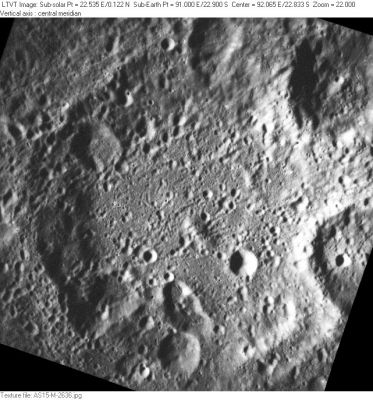Curie
Contents
Curie
| Lat: 22.9°S, Long: 91.0°E, Diam: 151 km, Depth: 3.85 km, Rükl: (farside), pre-Nectarian |
Table of Contents
[#Curie Curie]
[#Curie-Images Images]
[#Curie-Maps Maps]
[#Curie-Description Description]
[#Curie-Description: Wikipedia Description: Wikipedia]
[#Curie-Additional Information Additional Information]
[#Curie-Nomenclature Nomenclature]
[#Curie-LPOD Articles LPOD Articles]
[#Curie-Bibliography Bibliography]

Apollo 15 image A15-M-2636 Using his clock-face-based lettering scheme (see NASA RP-1097, p. 6), Ewen Whitaker assigned letters to some of the more prominent nearby craters. Visible in the Apollo view shown above are 25-km Curie Z (at top), 47-km Curie C (at 2 o’clock), 47-km Curie G (at 4 o’clock), 12-km Curie K (to its west on the main crater floor), and 21-km Curie V (inside the rim at 10 o’clock).
Images
LPOD Photo Gallery Lunar Orbiter Images Apollo Images
Maps
(LAC zone 100A4) USGS Digital Atlas PDF
Description
Description: Wikipedia
Additional Information
Depth data from Kurt Fisher database
- Westfall, 2000: 3.85 km
Dark spot on the southern part of Curie's floor, west-southwest of Curie K, see page 200 (LAC 100) in B.Bussey's and P.Spudis's Clementine Atlas of the Moon.- DannyCaes DannyCaes Dec 6, 2012
Nomenclature
- Named for Pierre Curie (May 15, 1859 – April 19, 1906), a French physicist, a pioneer in crystallography, magnetism, piezoelectricity and radioactivity. He shared the 1903 Nobel Prize in physics with his wife, Maria Sklodowska-Curie (Marie Curie), and Henri Becquerel, "in recognition of the extraordinary services they have rendered by their joint researches on the radiation phenomena discovered by Professor Henri Becquerel."
- The name "Curie" was assigned to this crater by the IAU in 1970. Pierre Curie had probably been previously honored by the name "Sklodowska-Curie" which had been assigned to the crater presently known as Sklodowska in 1961. However, that name was very similar to "Joliot-Curie", a northern hemisphere name also assigned in 1961. The 1970 decision to name this crater and change the names of the other two was based on the thought that it would be less confusing to have three separately named craters, each with a one-word name. - JimMosher JimMosher
LPOD Articles
Bibliography
Harold Hill. A Portfolio of Lunar Drawings, pages 226, 227 (observations of the averted hemisphere).
This page has been edited 1 times. The last modification was made by - tychocrater tychocrater on Jun 13, 2009 3:24 pm - afx3u2